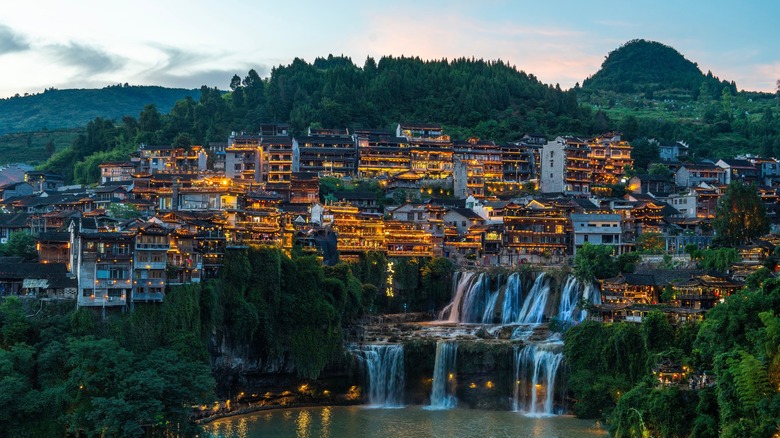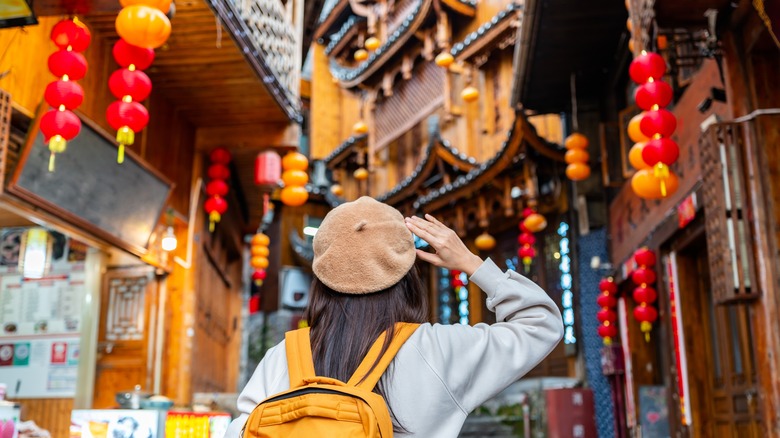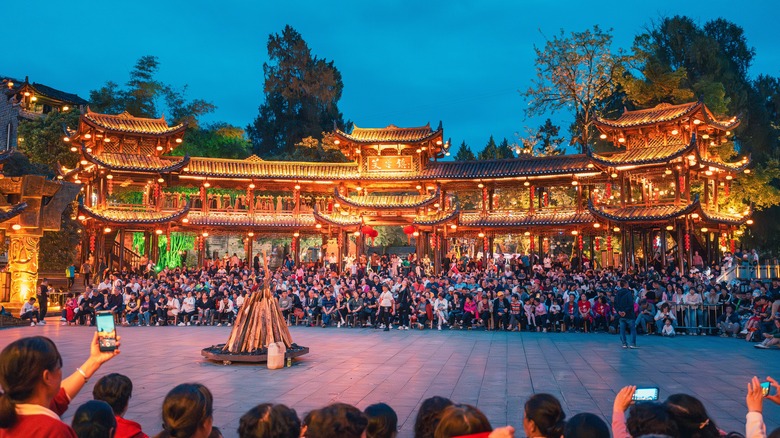This Ancient Chinese Village Is Famed For Looking Like A Fairytale Town Sitting On Waterfalls
There are many unique places and attractions to explore in China, from the bucket-list-worthy Great Wall of China to the Avatar-like Zhangjiajie National Forest Park in Hunan Province. But there is only one ancient Chinese village set atop waterfalls that looks like it was plucked straight from the pages of a fairytale: Furong. Located close to Zhangjiajie National Forest Park, Furong is in the heart of China's Hunan Province. Often called the "ancient town hanging on a waterfall" and "Furong Ancient Town," it's known for its cascading waterfalls, stone-paved streets, and timeworn architecture.
Furong ("hibiscus" in Chinese), originally known as Wangcun, has a history that stretches back more than 2,000 years. It was founded by King Tusi in 202 B.C., during the Han Dynasty. The Tujia ethnic group, China's eighth-largest ethnic minority, makes up more than 80% of the population, with the rest being predominantly Miao and Han communities. These minority populations have left a distinct mark on Furong in the form of ethnic folk customs, cultural relics, and local experiences.
Despite its age, Furong is remarkably well-preserved and has retained much of its ancient quality. The village's architecture showcases this past, with many buildings featuring traditional wooden structures, upturned eaves, and intricate carvings that define classical Chinese design. As you arrive and begin to stroll through its narrow alleys, it's easy to go back in time and imagine the village as it once was. Ultimately, Furong is a must-visit for those seeking an authentic, historical, and picturesque experience in China.
The waterfalls and charms of Furong
Furong is impressively built atop cliffs above a waterfall that falls into the You River, which sets it apart from other towns. The 131-foot-wide waterfall, which plunges nearly 197 feet into the You River below, is the focal point and has become synonymous with the town itself — it's also the largest waterfall in western Hunan. The waterfall is most spectacular between June and August, during the rainy season. Skip China's highest waterfall (a total tourist trap) and come here instead.
Visitors can take in the views of the waterfalls from various vantage points throughout the village. The most popular spot is the viewing platform near the entrance to the town. For a more immersive experience, many choose to venture closer, following the stone paths that wind their way down to the river's edge and even behind the waterfalls themselves. At night, the views of the waterfalls and the village itself are equally beautiful. The town is listed as a national 4A-level scenic spot for a reason!
Beyond its natural beauty, Furong is a treasure trove of cultural heritage. There is much to do: Explore the cliffside Tujia Diaojiaolou buildings, catch a traditional performance, walk along the 1.5-mile-long Wuli Slate Street (pictured), check out the Folk Museum, see the Tuwang Bridge, admire Tusi Palace, and see one of the most important Tujia relics, the 5,511-pound Xizhou Bronze Pillar. Taste local delicacies like rice tofu, Tujia bacon, Tujia hot pot, glutinous rice cakes, and ginger candy.
Tips for your visit
The village itself is not very large (17 square miles, all in all), and you can complete your entire visit within a few hours (three to six) or a day's time. Overnight stays are also recommended, as the town looks magical when lit up at night. To enter the Furong Scenic Area, you must pay a ticket fee of 100 RMB. Buses and private transfers are available, and there are regularly running bullet trains from Changsha (three hours, in operation from 9:30 a.m. to 6:30 p.m.), Fenghuang (40 minutes, in operation from 9 a.m. to 9:10 p.m.), and Zhangjiajie (30 minutes, in operation from 7:30 a.m. to 3:55 p.m.). There is no airport in town, but the bullet trains are reliable, fast, and comfortable.
To many's surprise, Furong is not a crowded tourist trap. Due to its remote location, Furong is quiet, authentic, and not commercialized compared to other scenic towns. April to October is the best time to visit because of optimal weather, while the winter, between November and February, is very cold, and most buildings lack proper heating. Usually, travelers combine Furong with a visit to Zhangjiajie and other destinations in Hunan. You might feel tempted to hire a tour guide, but Furong is easy enough to explore on your own without worrying about going off-course or missing out on any attractions — just get lost and see what you'll find. Make sure to know some of these essential words and phrases before your trip.


